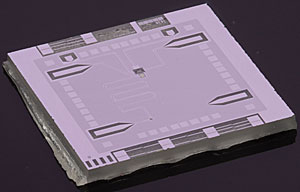A research team at the National Institute of Standards and Technology (NIST) has developed a chip-based tunable superconducting circuit that can position an individual microwave photon or a light particle in dual colours or frequencies simultaneously.
 The NIST prototype 'Optics Table on a Chip' places a microwave photon in two colors at once.
The NIST prototype 'Optics Table on a Chip' places a microwave photon in two colors at once.
This strange super positioning is actually a miniature chip-sized version of a normal optics experiment that uses a beam-splitter to send a photon in two different directions to pass through a table of mirrors, lasers, and lenses. The NIST circuit can be utilized to develop and control various forms of quantum states and can be considered as a prototype for an innovative table-on-a-chip.
NIST researchers also developed the first microwave-based bit that can be used in linear optical quantum computers. Such computers are visualized to store data either in the light beam’s path or in the orientation of single photons. However, a microwave device will store data in the frequency of a photon.
The NIST circuit integrates components that are used in experiments conducted with superconducting quantum computers such as a naturally resonating or vibrating cavity at specific frequency, an individual photon source, and a superconducting quantum interference device (SQUID). Researchers adjusted the properties of SQUID to enable coupling of the cavity’s two resonant frequencies. A photon was made to oscillate between varied superpositions of the coupled frequencies.
For example, the photons can oscillate from 50/50 or equal proportions of the two frequencies to an unequal split of 75/25. This helps to capture photons in a box rather than navigating them to pass through an optical table. NIST research team can manipulate the coupling of the new circuit with varied quantum states of the resonator over a specific time period. Thus, they can generate series of interactions to produce simple optical circuits.